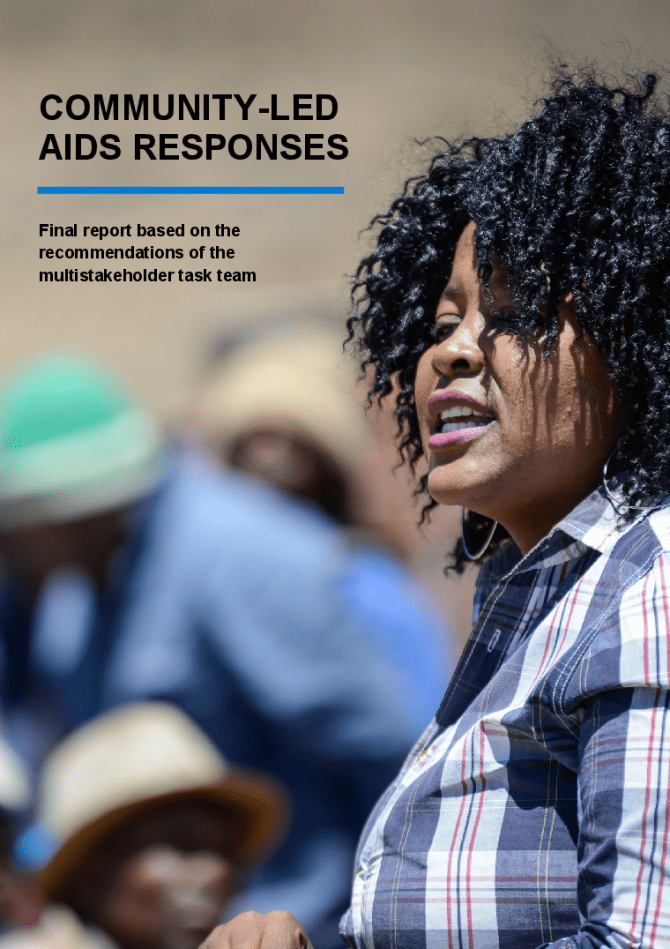国連合同エイズ計画(UNAIDS)の第51回プログラム調整理事会(PCB)が12月13日から16日まで、タイのチェンマイで開かれました。その3日目にあたる15日には、UNAIDSマルチステークホルダー特別委員会が2年間の協議を経てまとめた報告書『COMMUNITY-LED AIDS RESPONSES(コミュニティ主導のエイズ対応)』が公表されています。UNAIDSの同日付プレスリリースによると、報告書では《「コミュニティ主導のパンデミック対応」について国際的な定義が初めて示された》ということです。エイズだけでなく「COVID-19、M痘、エボラの流行拡大を抑え、次のパンデミックに備えるためにも、政府とコミュニティの協力が必要です」とUNAIDSの幹部はコメントしています。

気になりますね。報告書のPDF版を見ると、表紙の次のページに Community-led responses(コミュニティ主導の対応)の定義が次のように書かれています。
https://www.unaids.org/en/resources/documents/2022/MTT-community-led-responses
日本語にすると「何、言ってんだか」という感じになってしまいますが、これは訳者の力不足のせいでしょうね。一応、英文と併記しておきます。
Actions and strategies that seek to improve the health and human rights of their constituencies, that are specifically informed and implemented by and for communities themselves and the organizations, groups and networks that represent them.
(コミュニティを構成する人たちの健康と人権状況の改善に向けた行動と戦略。コミュニティ自身、およびコミュニティを代表する組織、グループ、ネットワークがコミュニティを構成する人たちのために具体的に情報を提供し、対策の実施にあたる)
以下、プレスリリースの日本語仮訳も参考までに。
◇
コミュニティ主導の対策を支援しなければ、パンデミックは克服できない 政府・NGO・国連が指摘 UNAIDSプレスリリース
タイ・チェンマイ 2022.12.15 エイズ・パンデミック対策にはコミュニティ主導の対応が重要であり、重点的に資金を投入しなければならない。エイズ対策の国際会合がタイ・チェンマイで開かれ、政府・市民社会組織・国連機関の代表からは、他のパンデミック対策や今後予想されるパンデミックへの準備においてもコミュニティ主導のアプローチが鍵にぎることになるとの指摘が相次いだ。また、会合では「コミュニティ主導のパンデミック対応」について国際的な定義が初めて示された。世界の各地域にまたがる11カ国政府と11の市民社会組織代表による2年間の協議を経てまとめられた定義で、世界保健機関(WHO)と国連開発計画(UNDP)が共同で招集した国連合同エイズ計画(UNAIDS)マルチステークホルダー特別委員会が報告書を作成し、UNAIDSの第51回プログラム調整委員会でその成果を報告した。
新たな定義と勧告に基づき、ドイツのカール・ラウターバッハ保健相とUNAIDSのウィニー・ビヤニマ事務局長は本日、ランセット誌への投稿で、包括的な「コミュニティ・パンデミック対策基盤」の整備を呼びかけている。この対策基盤は、パンデミックの予防、および発生時の準備と対応に関する新たな計画策定や国際的な取り決め、資金調達などを含むものだ。著者らはその記事の中で、効果的なパンデミックの予防、準備、対応には、政府の動きと相乗的に機能し得る強力なコミュニティの対策基盤が必要なこと、ただし、現状ではそうした要素は無視されていることを指摘している。また、エイズ、M痘、COVID-19、およびエボラから得られたエビデンスを示しつつ、コミュニティ主導の組織がいかに対策の信頼性を高め、コミュニケーションのチャネルを確保し、社会的に疎外されがちな人たちに手を差し伸べることを通して、政府の役割を補完し、公平性を担保してきたのかを説明している。
新たな国際定義と勧告は、エイズや他のパンデミック対策の計画立案者や資金提供者にとって、コミュニティ対応の効果を高めるには何が必要なのかを確認する助けになる。コミュニティ主導の組織は基本的に「公式・非公式に関わりなく、...管理者、指導者、スタッフ、スポークスパーソン、メンバー、ボランティアの大多数の経験や視点、意見を反映し、代表し、構成員に対する説明責任の透明なメカニズムを有するグループやネットワーク」と定義されている。「すべてのコミュニティベースの組織がコミュニティ主導であるとは限らない」という点に注意しておくことも重要である。
「研究所や病院などは対策基盤として理解されやすく、重要でもありますが、パンデミックに対し効果的に対応するには同時に、コミュニティ・インフラストラクチャ―も不可欠です。そこには、アウトリーチを行う人たち、排除されたコミュニティが信頼して話をできる代弁者、独立した説明責任のメカニズム、および意思決定への参加といったものが含まれているのです」とUNAIDS政策アドボカシー・知識担当事務局次長代理、マシュー・カバナ博士は説明する。「政府、市民社会、国際機関の代表からなる特別委員会は、コミュニティ主導に向けた能力強化とモニタリングを支援する重要なツールを新たに提供しました。コミュニティがインフラストラクチャとして有効に機能するよう、能力強化とモニタリングと資金確保を行わなければ、エイズ終結も他のパンデミックを止めることもできません」
チェンマイで開かれている国連合同エイズ計画(UNAIDS)のプログラム調整理事会では、コミュニティ主導の対応を促すための法律や政策の策定に向け、加盟国および非政府の参加者による対話も行われた。マルチステークホルダー特別委員会の勧告には、コミュニティ主導の組織に対する資金提供システムの改善と開発;コミュニティ主導の能力に関するモニタリング;コミュニティグループが作成したデータの活用と対策への統合管理などが含まれている。資金の確保に関しては、国内および国際的な資金調達メカニズムにおける法的、能力的な規制、および適格性の問題に直面することがしばしばある。
エイズ・パンデミックの終結について、理事会メンバーからは、計画、予算、実施、モニタリング、評価のすべての面でコミュニティのHIV対応を国のエイズ戦略の一環として位置づけなければならないとの指摘がなされた。
今回の原則はエイズだけに適用されるものではない。「COVID-19、M痘、エボラの流行拡大を抑え、次のパンデミックに備えるためにも、政府とコミュニティの協力が必要です。コミュニティ主導の対応を定義および評価する新たな枠組みの合意により、エイズ終結を妨げている不平等に対し、より効果的に立ち向かうことができるようになります」とカバナ博士は述べている。
タイでは、会合の参加者自身が見届けたように、キーポピュレーション主導の保健サービスがHIV感染の高いリスクに直面する人たちに届き、アジア・太平洋地域で最も公平なHIV 対策が実現している。南アフリカでは、HIV陽性者組織『Ritshidze』のメンバーとコミュニティリーダーが診療所やコミュニティを訪れ、COVID-19、HIV、結核のサービスに対する評価を行うとともに、長い待ち時間や個人情報保護の不備が人びとを医療サービスから遠ざけていることに管理者が責任を持って対応するよう求めている。ウクライナのHIV陽性者ネットワークである『100% Life』は、戦争状態の中でピアネットワークを活用して避難民と連絡を取り、医薬品、食料、緊急支援の提供を続けている。
「国際的なパンデミック協定や資金提供の取り決めには、コミュニティ主導の能力強化に向けた具体的な目標を含めなければなりません」とカバナ博士は言う。「パンデミック対策が効果を上げるには、一方通行のコミュニケーションを改め、コミュニティがあらゆるレベルで意思決定に参加できるようにする必要があります。コミュニティのリーダーシップは、単にあったらいいねというものではなく、パンデミックの終結に不可欠なのです」
ドイツ保健大臣とUNAIDS事務局長によるランセットの記事はこちらから。
https://www.thelancet.com/journals/lancet/article/PIIS0140-6736(22)02575-2/fulltext
UNAIDSプログラム調整理事会で報告されたレポートはこちらから。
https://www.unaids.org/en/resources/documents/2022/MTT-community-led-responses
コミュニティ主導のパンデミック対応に関する資料はこちらから。
https://www.unaids.org/en/topic/Community-pandemic-response
PRESS RELEASE
Pandemics can only be defeated if communities are supported to lead, say governments, NGOs and UN
CHIANG MAI, THAILAND, 15 December 2022—Community-led responses are a critical part of the AIDS pandemic response, and must be prioritised in resourcing. The approach, set out by governments, civil society organisations and United Nations agencies at an international meeting on AIDS in Chiang Mai, Thailand, will also be key for tackling other pandemics and for preparing for the pandemics to come, delegates said. The meeting saw the first international definition of a community-led response to a pandemic, published after a two-year consultative process that brought together 11 governments, representing each region of the world, and 11 civil society representatives. This UNAIDS multi-stakeholder task team on community-led responses was co-convened by the World Health Organization and United Nations Development Programme, and presented outcomes to the 51st Programme Coordinating Board meeting of the UN Joint Programme on HIV and AIDS.
Using the new definitions and recommendations, German Federal Health Minister Prof. Karl Lauterbach and the UNAIDS Executive Director Winnie Byanyima published an article in The Lancet today calling for inclusion of comprehensive “community pandemic infrastructure” in pandemic prevention, preparedness and response in new planning, international agreements, and financing. In it, the leaders show that strong community infrastructure, working synergistically with government, is a necessary but neglected element of effective pandemic prevention, preparedness, and response. Using evidence from AIDS, mpox, COVID-19, and Ebola, the authors describe how community-led organisations bring trust, communications channels, and reach to marginalised groups that complement government roles and improve equity.
The new international definitions and recommendations can help planners and funders for AIDS and other pandemics identify the elements of an effective community response. Community-led organizations, defined as "groups and networks, whether formally or informally organized ... for which the majority of governance, leadership, staff, spokespeople, membership and volunteers, reflect and represent the experiences, perspectives, and voices of their constituencies and who have transparent mechanisms of accountability to their constituencies,” form a backbone of that response. Crucially, it is noted that "not all community-based organizations are community-led.”
"While what is most often understood as infrastructure – like labs and hospitals – are important, also essential to effective pandemic response is the community infrastructure which includes people to do outreach, trusted voices who can speak to excluded communities, independent accountability mechanisms, and participation in decision-making,” explained Dr Matthew Kavanagh, UNAIDS Deputy Executive a.i for Policy, Advocacy and Knowledge. “This task team of governments, civil society, and international organizations has given important new tools to support the building and monitoring of community-led capacity. We will only be able to end AIDS and stop other pandemics by ensuring that this community infrastructure is intentionally enabled, strengthened, monitored, and resourced.”
The United Nations Joint Programme on HIV/ AIDS (UNAIDS) Board meeting in Chiang Mai included dialogue between member states and non-state participants on how to develop laws and policies to facilitate community-led response. The recommendations of the multistakeholder task team include developing better systems for financing community-led organisations, which often face legal, capacity, and eligibility barriers to national and international financing mechanisms; monitoring community-led capacity; and integrating data generated by community groups into response management.
To end the AIDS pandemic, board members pointed out, community responses to HIV must be integrated into all levels of countries’ AIDS strategies including planning, budgeting, implementation, monitoring and evaluation.
The principles developed apply not only to AIDS. "Stopping COVID-19, mpox, and Ebola, and preparing for the next pandemic, all require that partnership of government and community together. The newly agreed framework for defining and measuring community-led responses make us better equipped to address the inequalities that are holding back progress in ending AIDS,” said Dr Kavanagh.
In Thailand, as delegates saw for themselves first hand, key-population-led health services have reached people at increased risk of HIV, achieving among the most equitable HIV responses in the region. In South Africa, community leaders with Ritshidze, which represents people living with HIV, visit clinics and communities to assess COVID-19, HIV, and tuberculosis services and hold administrators accountable for addressing issues such as long waiting times or confidentiality gaps that keep some people away from health services. Amid war, Ukraine’s 100% Life, a network of people living with HIV, has used peer networks to communicate with displaced people, delivering medicines, food, and emergency assistance.
"International pandemic agreements and funding should include specific goals for community-led capacity," said Dr Kavanagh. "To be effective, pandemic responses need to move beyond one-way communications to bring communities into decision making at all levels. Community leadership is not mere nice-to-have. It is essential for ending pandemics."
The Lancet article marking the occasion by the German Health Minister and the UNAIDS Executive Director is here.
The report presented at the UNAIDS Programme Coordinating Board meeting is here.
Resources on Community Led Pandemic Response are here.